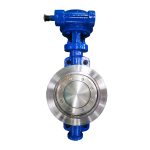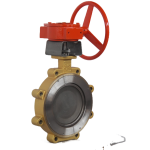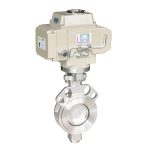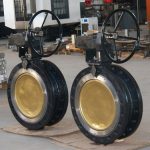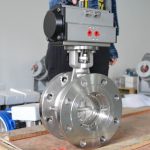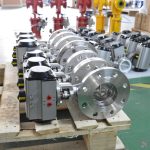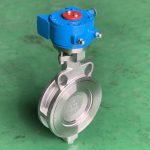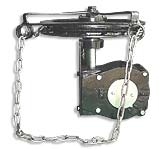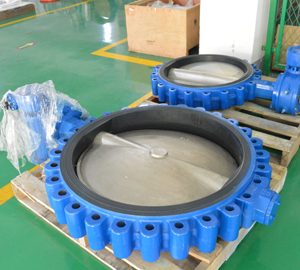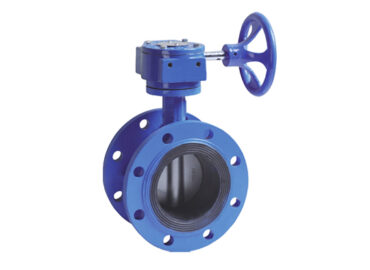In the vast world of industrial flow control, butterfly valve play a critical role in regulating the passage of fluids. These valves come in various types, each offering unique features and benefits to suit different applications. Among them, Concentric, Double-Offset, and Triple-Offset Butterfly Valve are the most commonly used across numerous industries in the USA. This blog post aims to provide a comprehensive comparison of these three types of butterfly valve, diving deep into their structures, operations, pros and cons, and industries they serve. We will also shed light on the current market trends for each type in the USA and what the future might hold. Whether you’re an industry professional or just interested in learning more about these essential devices, this guide will give you valuable insights.
Introduction
Butterfly valve are a fundamental component in numerous industrial applications across the USA, and they come in various types, namely Concentric, Double-Offset, and Triple-Offset Butterfly Valve. Each type boasts unique features and benefits, making them suitable for different applications. Starting with Concentric Butterfly Valve, these are the most basic form of butterfly valve, often used in low-pressure and temperature applications due to their simple design where the disc is centered within the valve body, as Crane Engineering explains. On the other hand, Double-Offset Butterfly Valve, also known as High-Performance Butterfly Valves, have two offsets that make them more resistant to wear and tear, allowing them to handle higher pressures and temperatures. The first offset is the shaft placement, which is off-center of the valve or pipe’s bore axis, and the second offset is the shaft located to one side of the valve or pipe centerline, as XHVal illustrates. Lastly, we have Triple-Offset Butterfly Valve, renowned for their ability to handle high-pressure systems and extreme temperatures. The third offset in these valves involves a conical profile of the seating surface, ensuring minimal wear and enhancing longevity. This makes Triple-Offset Butterfly Valves ideal for challenging applications that require zero leakage, as QRC Valves points out. Understanding these differences is crucial for selecting the right butterfly valve for your specific needs, ensuring optimal performance and efficiency.
Brief introduction to butterfly valves.
Butterfly valves, a crucial piece of equipment in the flow control industry, are used to regulate and isolate the flow of various types of fluids in a system. The name ‘butterfly’ is derived from the metal disc, or the butterfly plate as it’s often called, situated in the middle of the pipe. The rotation of this disc, which is connected to a handle or actuator on the outside, controls the flow of fluid. When the handle is turned, the disc turns to a parallel or perpendicular position to the flow of fluid, thus allowing full, partial, or no flow. Because of their simple design, durability, and efficiency, butterfly valve are widely used across many industries including water supply, wastewater treatment, fire protection, and power generation. Their compact size and lower cost relative to other valve types also make them a preferred choice for many applications.
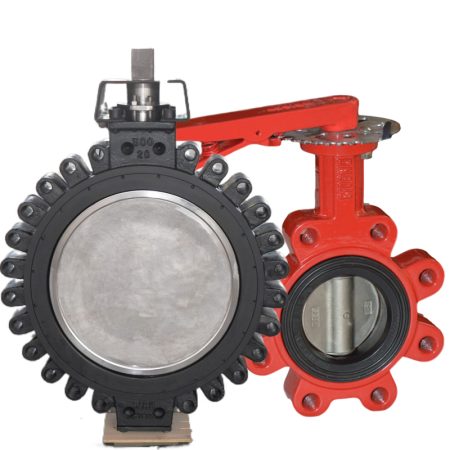
Understanding Butterfly Valves
Butterfly valves, a core element in the flow control sector, are ingeniously designed devices used to regulate, direct, and isolate the flow of different types of fluids within a system. The concept behind their name is quite simple; it’s derived from the disc or “butterfly” that is centrally located within the pipe’s diameter. This disc is attached to a handle or actuator on the exterior of the valve. By rotating this handle, the disc (which can be parallel or perpendicular to the fluid flow) is turned, allowing for full, partial, or no flow at all. What sets butterfly valves apart is their straightforward and efficient design, which allows for swift operation and minimal pressure drop across the valve. They are renowned for their durability, often withstanding harsh conditions and demanding applications. Butterfly valves find extensive use across a plethora of industries, including but not limited to water and wastewater treatment, oil and gas, power generation, and fire protection. They are favored due to their compact size and relatively lower cost compared to other types of valves. Furthermore, butterfly valves come in several types—concentric, double-offset, and triple-offset—each with unique features and benefits, making them suitable for various applications. Understanding how butterfly valves function and their potential applications is crucial for industries that rely on efficient and reliable flow control systems.
Explanation of what butterfly valves are and their importance in various industries.
Butterfly valves are a type of flow control device used to regulate or halt the flow of fluids in a system. They consist of a disc, often called a “butterfly”, mounted on a rotating shaft. When the shaft is turned, the disc either allows the fluid to pass through (when in a parallel position) or blocks it (when in a perpendicular position). Butterfly valves are widely used across various industries due to their simple design, cost-effectiveness, and excellent functionality. In the oil and gas industry, they’re essential for safe and efficient pipeline management. In water treatment facilities, they’re used for isolating and controlling the flow of water. Similarly, in the power generation sector, they’re employed in cooling systems to regulate the flow of coolants. In the chemical industry, butterfly valves’ ability to handle a wide range of temperatures and pressures makes them ideal for controlling the flow of aggressive chemicals. Overall, the importance of butterfly valves in these industries cannot be overstated, as they play a pivotal role in ensuring operational efficiency and safety.
Insight into how butterfly valves work.
Butterfly valves function on a relatively simple, yet effective principle. At the heart of the valve is a disc, often referred to as the “butterfly”, which is mounted on a rotating shaft. This disc is the primary component responsible for controlling the flow of fluids. When the butterfly valve is open, the disc is turned parallel to the direction of the fluid flow, allowing fluid to pass through with minimal obstruction. On the other hand, when the valve is closed, the disc is rotated to a position perpendicular to the fluid flow, completely blocking the passage and thus stopping the fluid flow. The degree of rotation of the disc determines the extent of the fluid flow; a partially open valve allows for a controlled, reduced flow. The disc is operated manually or mechanically using a handle or an actuator, respectively. This simple mechanism of operation, combined with their durability and cost-effectiveness, makes butterfly valves a popular choice in various industries for flow control applications.
Types of Butterfly Valves
Butterfly valves, widely used in numerous industries for flow control, come in various types designed to meet specific application requirements. The three primary types are the concentric, double-offset, and triple-offset butterfly valves. Concentric butterfly valves, also known as resilient-seated butterfly valves, are the most common type. They feature a disc concentrically mounted in the middle of the pipe, and a rubber seat that the disc closes against. These valves are typically used in low-pressure and temperature applications, such as water distribution and HVAC systems. Double-offset butterfly valves, or high-performance butterfly valves, have a stem that is offset from the center of the disc and from the center of the body, which reduces friction between the disc and seal during operation. This makes them suitable for higher pressure and temperature applications, and they offer longer service life than concentric valves. Finally, triple-offset butterfly valves have an additional offset; the sealing surface is angled in relation to the centerline, which ensures that the metal seat and seal do not rub, reducing wear and providing a tighter seal. This design allows them to handle very high pressures and temperatures, making them ideal for use in critical applications in industries like oil and gas, and power generation. Each type of butterfly valve offers unique advantages, and understanding these can help in selecting the right valve for a given application.

Introduction to three types of butterfly valves: Concentric, Double-Offset, and Triple-Offset.
Butterfly valves, a crucial component in many fluid flow systems, come in three main types: Concentric, Double-Offset, and Triple-Offset. Each type is designed to serve specific operational needs based on pressure, temperature, and sealing requirements.
- Concentric Butterfly Valves: Also known as resilient-seated butterfly valves, concentric butterfly valves have a disc mounted in the center of the pipe and a rubber seat against which the disc closes. These valves are typically used for low-pressure and temperature applications where tight sealing isn’t critically required, such as water distribution systems and HVAC systems.
- Double-Offset Butterfly Valves: These valves, also known as high-performance butterfly valves, feature a stem that’s offset from both the center of the disc and the center of the body. This double offset design reduces friction between the disc and the seal during operation, facilitating longer service life and making the valve suitable for higher pressure and temperature applications.
- Triple-Offset Butterfly Valves: The most advanced of the three, triple-offset butterfly valves have an additional offset—the sealing surface is angled in relation to the centerline. This design prevents rubbing between the metal seat and seal, reducing wear and providing a tighter seal. These valves can handle very high pressures and temperatures, making them ideal for critical applications in industries like oil and gas, and power generation.
Each of these butterfly valves has unique advantages, and the choice among them depends on the specific requirements of the application.
Brief explanation of each type.
Butterfly valves are categorized into three main types: Concentric, Double-Offset, and Triple-Offset, each with unique characteristics and uses.
- Concentric Butterfly Valves: This is the simplest type of butterfly valve, featuring a disc that is centrally mounted within the pipe and a rubber seat against which the disc closes. They’re primarily used in systems where the pressure and temperature are low, such as water distribution and HVAC systems. Despite their simplicity, they are highly efficient for these applications.
- Double-Offset Butterfly Valves: Also known as high-performance butterfly valves, their design includes a stem that is offset from the center of the disc and from the center of the body. This double-offset reduces friction between the disc and the seal during operation, increasing the valve’s lifespan. These valves are suitable for higher pressure and temperature applications due to their enhanced durability and performance.
- Triple-Offset Butterfly Valves: In this design, an additional offset is introduced where the sealing surface is angled in relation to the centerline. This prevents any direct contact between the metal seat and the seal, reducing wear and providing a tighter seal. These valves are capable of handling very high pressures and temperatures, making them ideal for critical applications in industries such as oil and gas, and power generation.
In conclusion, the type of butterfly valve chosen depends on the specific requirements of the system in which it will be installed.
Concentric Butterfly Valves
Concentric Butterfly Valves, also known as resilient-seated butterfly valves, are the most common type of butterfly valves and are characterized by their simple yet efficient design. In these valves, the stem is located in the center of the disc, which is itself positioned directly in the middle of the pipe. This arrangement allows for a simple 90-degree on-off rotation that effectively controls the flow of fluid within the pipe. The valve’s sealing mechanism involves the disc closing against an elastomeric seat, often made of rubber, which surrounds the disc. This provides a generally effective seal but may not be absolutely leak-tight, particularly under higher pressures or temperatures. However, for many applications, especially those involving lower pressures and temperatures, such as in water distribution systems, HVAC systems, and certain chemical applications, this level of sealing is entirely adequate. The simplicity of the concentric butterfly valve’s design lends itself to cost-effectiveness, both in terms of initial purchase price and maintenance costs. It also allows for the valve to be relatively lightweight and compact, making it easy to install and handle. Despite their simplicity, concentric butterfly valves are incredibly versatile and can be used with a wide range of fluids, including water, oil, and gas, and even certain semi-solid materials. Overall, while they may not be suitable for all applications, concentric butterfly valves offer a highly efficient and cost-effective solution for many flow control situations.
Detailed description of Concentric Butterfly Valve – structure, operation, and common usage.
Concentric Butterfly Valves, also known as resilient-seated butterfly valves, have a straightforward and efficient design. Structurally, they feature a disc located right at the center of the pipe, and a stem that is also centrally positioned within the disc. The disc, which is the main flow control element, rotates around the stem, providing a quick and efficient 90-degree on-off rotation. This design results in a symmetrical flow pattern with very little resistance, making these valves ideal for applications requiring regular and efficient flow control. The sealing mechanism involves the disc closing against a resilient seat, usually made from an elastomer like rubber, that lines the inside of the valve body. While this design generally provides an effective seal, it may not be completely leak-proof under higher pressures or temperatures.
Operationally, concentric butterfly valves are simple to use. The central positioning of the stem allows for easy and direct control of the disc’s position, typically through a manual handwheel or an automated actuator. Turning the handwheel or activating the actuator causes the disc to rotate, either opening to allow flow or closing to prevent it.
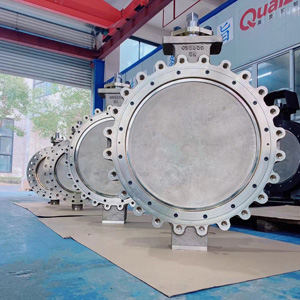
In terms of usage, concentric butterfly valves marine are commonly used in systems where the pressure and temperature are relatively low. They are often found in water distribution systems, HVAC systems, and certain chemical processing applications. Their simple design and operation make them a cost-effective choice for these types of applications, where the sealing requirements are not excessively stringent. However, they may not be suitable for applications involving high pressures, high temperatures, or corrosive fluids, where a more robust sealing mechanism would be required.
Pros and cons of using Concentric Butterfly Valve.
Concentric Butterfly Valves come with various advantages and some limitations as well. On the positive side, their simple design makes them cost-effective to manufacture, purchase, and maintain. They’re easy to install due to their lightweight, compact size, and the symmetrical flow pattern they create results in minimal pressure drop across the valve, enhancing system efficiency. The 90-degree on-off rotation provides quick and efficient operation, making them ideal for applications requiring frequent flow control. Their versatility allows them to be used with a wide range of fluids, from water and oil to certain chemicals and even semi-solid materials.
On the downside, the sealing mechanism in concentric butterfly valves, which involves the disc closing against a rubber seat, may not provide an absolutely tight seal. This could result in slight leakage, particularly under higher pressures or temperatures. This type of valve is not suitable for high-pressure and high-temperature applications as the rubber seat can degrade under such conditions, leading to a potential failure of the seal. Also, they may not be ideal for use with certain corrosive or abrasive fluids, which could damage the disc or the seat. In summary, while concentric butterfly valves offer many benefits, their suitability depends heavily on the specific requirements of the application.
Examples of industries in the USA that use Concentric Butterfly Valve.
Concentric Butterfly Valves are widely used across numerous industries in the USA due to their versatility, efficiency, and cost-effectiveness. The water and wastewater industry is one prime example where these valves are commonly used for flow control in treatment plants and distribution systems. They’re also popular in the HVAC industry, controlling the flow of heating and cooling substances in commercial and residential buildings. Within the chemical industry, they are often used for handling less aggressive chemicals in lower pressure environments. In the oil and gas industry, while they may not be suitable for high-pressure pipelines, they find usage in lower pressure applications such as in storage facilities or processing plants. The food and beverage industry also employs these valves for handling various liquids during processing and packaging. Moreover, they are used in fire protection systems, irrigation systems, and even in certain power generation applications. However, the specific use within each industry depends on the particular system requirements, including pressure, temperature, and the nature of the fluid being controlled.
Double-Offset Butterfly Valve
Double-Offset Butterfly Valves, also known as high-performance butterfly valves, are a significant improvement over standard concentric butterfly valves. Their unique design involves two distinct ‘offsets’. The first offset is the positioning of the stem from the centerline of the disc, and the second offset is the positioning of the stem from the centerline of the pipe. This double-offset design allows the disc to move off the seat in a cam-like motion rather than the direct in-out motion seen in concentric butterfly valves.
This movement reduces friction between the disc and the seat throughout the operation, increasing the valve’s lifespan and reducing wear and tear. It also allows for a tighter seal when the valve is closed, making these valves suitable for higher pressure and temperature applications compared to their concentric counterparts. Moreover, this tight seal makes them more effective for throttling purposes, offering better control over the flow rate.
Double-offset butterfly valves typically have a metal seat, which gives them a higher temperature and pressure rating. However, they can also have soft seats, usually made from PTFE or other resilient materials, for applications requiring a tighter seal. These valves can be operated manually or automated with electric or pneumatic actuators, depending on the requirements of the system.
In terms of usage, double-offset butterfly valves are found in a wide range of industries where higher performance is required. These include power generation, oil and gas, chemical processing, and HVAC systems for large commercial buildings. They’re also used in water treatment plants and desalination facilities, where the ability to handle high pressures and temperatures can be crucial. Despite being more expensive than concentric butterfly valves, their enhanced performance and durability often make them a cost-effective choice for many high-demand applications.

Detailed description of Double-Offset Butterfly Valve – structure, operation, and common usage.
Double-Offset Butterfly Valves, also known as high-performance butterfly valves, feature a unique design that differentiates them from standard butterfly valves. In terms of structure, the valve consists of a disc that is positioned in the center of the pipe. The stem, which controls the disc, is placed not in the center but slightly offset from it. This is the first offset. The second offset comes from the fact that the stem is also offset from the centerline of the pipe. This double-offset design is what gives the valve its name.
The operation of the Double-Offset Butterfly Valve involves the stem turning the disc to open or close the valve. As the stem is turned, the double-offset design allows the disc to ‘cam’ off the seat, reducing friction and wear on the sealing surfaces. This leads to increased longevity of the valve and a tighter seal when the valve is closed. The valve can be operated manually, or it can be automated with an actuator, depending on the requirements of the application.
In terms of common usage, Double-Offset Butterfly Valves are used in a variety of industries due to their high performance and ability to handle higher pressures and temperatures than standard butterfly valves. They are commonly found in power generation, oil and gas, chemical processing, and HVAC systems for large commercial buildings. Despite being more expensive than standard butterfly valves, their enhanced performance, durability, and ability to provide a tight seal make them a popular choice for many applications.
Pros and cons of using Double-Offset Butterfly Valve.
Double-Offset Butterfly Valves offer several advantages that make them popular in many industries. One of the key benefits is their ability to handle higher pressures and temperatures compared to standard butterfly valves, thanks to their double-offset design and typically metal seat. This design also allows for reduced friction between the disc and the seat during operation, resulting in increased durability and longevity of the valve. The double-offset butterfly valves provide excellent flow control, making them effective for throttling applications.
However, there are also some drawbacks associated with Double-Offset Butterfly Valves. They are generally more expensive than standard butterfly valves, which may be a deterrent for some applications where budget is a primary concern. While they have a higher pressure and temperature rating due to the metal seat, this can sometimes result in a less effective seal compared to soft-seated valves, leading to potential leakage issues. Additionally, despite their improved performance, they are still not suitable for certain extreme high-pressure, high-temperature applications where other types of valves, such as gate or globe valves, might be more appropriate. Also, the maintenance and repair of these valves might be more complex and costly due to their intricate design.
Examples of industries in the USA that use Double-Offset Butterfly Valve.
In the USA, Double-Offset Butterfly Valves are used across a wide range of industries due to their high performance and adaptability. The power generation industry relies on these valves for their ability to handle high pressures and temperatures, controlling the flow of steam and other fluids in power plants. In the oil and gas sector, these valves are vital for managing the flow of crude oil, natural gas, and other petrochemicals through pipelines and processing facilities.
The chemical processing industry also uses Double-Offset Butterfly Valves to control the movement of various aggressive chemicals under high pressure and temperature conditions. HVAC systems in large commercial buildings often utilize these valves for effective fluid control. They are also commonly found in water and wastewater treatment plants, where they help manage the flow of water during treatment processes.
Moreover, these valves are utilized in the food and beverage industry, where they regulate the flow of liquids during the production process, and the pharmaceutical industry, where they ensure precise control of different substances. Despite their higher cost compared to standard butterfly valves, their ability to provide a tight seal and withstand demanding conditions makes them a preferred choice in these industries.
Triple-Offset Butterfly Valve
Triple-Offset Butterfly Valves, sometimes referred to as Triple-Eccentric Butterfly Valves, are a further development in butterfly valve technology. They are designed with three different offsets to overcome the limitations of both standard and double-offset butterfly valves. The first offset is the shaft placement, which is off-center from the pipe’s diameter, similar to the double-offset design. The second offset is that the shaft’s centerline is placed behind the disc/seal interface. The third offset, which distinguishes this valve from others, involves a conical profile of the sealing surfaces, which ensures that the disc seal only makes contact with the body seat at the final point of closure.
The operation of the Triple-Offset Butterfly Valve is quite similar to its counterparts. The stem rotates the disc to open or close the valve. However, because of the third offset, the disc moves in a kind of ‘cam action’, which means it does not rub against the seat when the valve is being opened or closed. This eliminates wear and tear on the sealing surfaces, thereby increasing the lifespan of the valve and ensuring a leak-tight, metal-to-metal seal.

Triple-Offset Butterfly Valves are used in many industries where high-performance, reliability, and durability are required. They can handle higher pressures and temperatures than double-offset valves, making them suitable for use in power generation, oil and gas, petrochemical, and chemical industries. They are particularly useful in applications dealing with corrosive and erosive media, high-pressure steam, and cryogenic applications. Despite being more expensive, their long-term benefits such as high durability, zero leakage, and lower maintenance costs make them an attractive choice for many industrial applications.
Detailed description of Triple-Offset Butterfly Valve – structure, operation, and common usage.
Triple-Offset Butterfly Valves, also known as Triple-Eccentric Butterfly Valves, are advanced control devices designed to offer superior performance under challenging conditions. Structurally, these valves feature three distinct offsets. The first offset involves the stem being placed behind the disc, allowing for a 360-degree rotation. The second offset is the stem’s alignment, which is off-center from the pipe’s diameter. The third offset, unique to this valve type, introduces a conical shape to the sealing surface, creating a seal that only makes contact at the final point of closure.
In terms of operation, the valve’s disc rotates around the stem, opening or closing the valve. The triple-offset design ensures a ‘cam action’ movement, where the disc doesn’t scrape against the seat, reducing wear and tear on the sealing surfaces. This results in a longer lifespan of the valve and ensures a reliable, leak-tight, metal-to-metal seal.
Commonly, Triple-Offset Butterfly Valve are used in industries requiring high performance and durability. They are capable of handling higher pressures and temperatures than double-offset valves, making them suitable for industries such as power generation, oil and gas, petrochemical, and chemical industries. In these sectors, they are often used in applications dealing with corrosive and erosive media, high-pressure steam, and cryogenic applications. Despite their higher initial cost, their long-term benefits such as high durability, zero leakage, and lower maintenance costs make them a preferred choice for many industrial applications.
Pros and cons of using Triple-Offset Butterfly Valve.
Triple-Offset Butterfly Valves have several notable advantages that make them an attractive choice for many industries. One of the primary benefits is their ability to handle high-pressure and high-temperature applications, which makes them suitable for sectors like power generation, oil and gas, and chemical industries. The unique ‘cam action’ movement of the valve disc prevents wear and tear on the sealing surfaces, ensuring a longer lifespan and a reliable, leak-tight seal. They are also excellent for throttling applications due to their precise flow control capabilities.
However, there are also some drawbacks associated with Triple-Offset Butterfly Valves. Firstly, they tend to be more expensive than other types of butterfly valves, which may deter industries operating on tighter budgets. The complex design can also lead to higher installation costs and may require specialized knowledge for maintenance and repairs. Furthermore, while they are built to handle high pressures and temperatures, they may not be the best choice for low-pressure applications where a simple, less expensive valve could suffice. Lastly, despite their durability, they might not be suitable for certain media types, especially those with suspended solids, as these can potentially damage the valve.
Examples of industries in the USA that use Triple-Offset Butterfly Valve.
Triple-Offset Butterfly Valves are utilized across a wide range of industries in the USA due to their robust design and reliable performance. One of the primary sectors that employ these valves is the oil and gas industry, where they are used for various processes that require high-pressure and high-temperature handling capabilities. This is evident from the data provided by Persistence Market Research. Additionally, the power and chemical industries also widely use these valves. Other notable sectors include the food and pharmaceutical industries, as highlighted by Dombor. Interestingly, these valves find applications beyond these traditional sectors. For instance, they are used in shipbuilding, HVAC systems, petrochemical plants, fire control systems, seawater handling, flue gas management, and desulphurization processes, according to Butterfly Valves & Controls Inc. The hot gas industry also utilizes Triple-Offset Butterfly Valves due to their excellent design and triple offset configuration, as reported by XINTAI Valve. Thus, the usage of Triple-Offset Butterfly Valves is quite diversified across various industries in the USA.
Comparing Concentric, Double-Offset, and Triple-Offset Butterfly Valve
Butterfly valves are essential components in various industrial applications due to their ability to control fluid flow. There are three main types of butterfly valves: Concentric, Double-Offset, and Triple-Offset, each with its unique characteristics, advantages, and drawbacks.
Starting with the Concentric Butterfly Valve, it is the simplest type among the three. In this valve, the stem is located in the center of the disc, and the disc is in the center of the pipe bore. This design allows for a 360-degree rotation of the disc. However, due to the disc coming into contact with the seat all around its circumference, this valve type is not suitable for high-temperature applications as the constant contact results in high wear and tear. Concentric Butterfly Valves are used in low-pressure, non-critical applications where tight shut-off is not necessary.
On the other hand, the Double-Offset Butterfly Valve, also known as a High-Performance Butterfly Valve, has two offsets. The first offset is the placement of the stem behind the disc, and the second offset refers to the stem being off-center from the pipe’s diameter. These offsets allow the disc to travel without scraping against the seat, reducing wear and tear and providing tighter sealing than Concentric Butterfly Valves. This valve type can handle higher pressures and temperatures, making it suitable for more critical applications.
Lastly, the Triple-Offset Butterfly Valve is the most advanced among the three types. In addition to the two offsets found in the Double-Offset Butterfly Valve, a third offset is introduced that involves a conical shape of the sealing surface. This design ensures that the seal only makes contact at the final point of closure, eliminating friction and resultant wear and tear during operation. As a result, these valves provide a reliable, leak-tight, metal-to-metal seal, making them suitable for handling high pressures and temperatures. They are often used in industries like power generation, oil and gas, and chemical industries.
In conclusion, while Concentric Butterfly Valves are ideal for simple, low-pressure applications, Double-Offset Butterfly Valves offer better performance for higher pressure and temperature applications. For the most demanding conditions requiring a tight seal and long lifespan, Triple-Offset Butterfly Valves are the preferred choice.

Comparative analysis of the three types of butterfly valve based on design, functionality, durability, cost-effectiveness, and suitability for different applications.
Butterfly valves, including Concentric, Double-Offset, and Triple-Offset types, have different designs that significantly affect their functionality, durability, cost-effectiveness, and suitability for various applications.
Concentric Butterfly Valves, featuring a simplistic design with the stem located in the disc center and the disc in the pipe bore center, are generally less durable due to the constant disc-to-seat contact causing wear and tear. However, they are cost-effective and suitable for low-pressure, non-critical applications where tight shut-off isn’t a priority.
Double-Offset Butterfly Valves, also known as High-Performance Butterfly Valves, have a more complex design with two offsets. The stem is placed behind the disc, and it’s off-center from the pipe’s diameter. This design reduces wear and tear, enhancing durability and providing tighter sealing than Concentric Butterfly Valves. They can handle higher pressures and temperatures, making them more expensive but suitable for critical applications.
Triple-Offset Butterfly Valves are the most advanced, incorporating a third offset involving a conical shape of the sealing surface. This eliminates friction and resultant wear and tear during operation, drastically improving durability. These valves provide a reliable, leak-tight, metal-to-metal seal, making them ideal for handling high pressures and temperatures. Although they are the most expensive, they offer excellent long-term cost-effectiveness due to their extended lifespan and reduced maintenance needs. They are often used in industries like power generation, oil and gas, and chemical industries where stringent sealing and durability requirements are necessary.
In summary, while Concentric Butterfly Valves are cost-effective for simple applications, Double-Offset Butterfly Valves provide a balance between performance and cost. In contrast, Triple-Offset Butterfly Valves, although more expensive initially, offer superior performance and durability, making them cost-effective in the long run.
Market Trends for Butterfly Valve in the USA
The butterfly valves market in the USA and globally is experiencing significant growth, driven by advancements in technology and increased demand across various industries. According to Allied Market Research, the global butterfly valves market size is projected to reach $13,667.0 million by 2025, up from $8,282.61 million in 2017, growing at a Compound Annual Growth Rate (CAGR) of 6.3% from 2018. Expert Market Research also supports this upward trend, predicting a CAGR of 4.1% from 2023 to 2028. Verified Market Research adds to this narrative, projecting the butterfly valves market size to reach USD 16.79 Billion by 2030, with a CAGR of 6.25% from 2023.
Key players contributing to these market dynamics include Schlumberger Limited, Emerson Electric Co., and L&T Valves Limited, as reported by Fortune Business Insights. The growth factors driving this market expansion include rising demand in the oil and gas industry, along with the growing food and beverages sector, which is expected to propel the United States Valves Market at a CAGR of 5.4% by 2027, according to Mordor Intelligence.
Moreover, the global butterfly valves market is predicted to garner $14,108.3 million in the 2021–2028 timeframe, growing from $9,028.1 million in 2020, demonstrating a healthy CAGR, as per Research Dive. IMARC Group further indicates that the global butterfly valve market size reached US$ 10.5 Billion in 2022, and is expected to reach US$ 14.0 Billion in the future.
Taken together, these trends suggest a positive outlook for the butterfly valves market in the USA and globally, backed by technological advancements, industry demand, and the presence of key market players.
Overview of the current market trends for each type of butterfly valve in the USA.
The butterfly valve market in the USA is experiencing growth with different trends observed for each type of butterfly valve. The High Performance Butterfly Valves, a category which encompasses Double-Offset Butterfly Valves, are seeing a surge in demand, according to a report on LinkedIn. This growth can be attributed to their balance of performance and cost-effectiveness, making them suitable for a variety of applications. For Concentric Butterfly Valves, although specific market data is not readily available, their cost-effectiveness for low-pressure applications suggests a steady market presence. As for the Triple-Offset Butterfly Valves, their superior performance and durability, though at a higher initial cost, make them ideal for high-pressure and high-temperature applications like those in the oil and gas industry. Overall, the butterfly valves market size was valued at $10.34 billion in 2022 and is projected to reach $16.79 billion by 2030, growing at a CAGR of 6.25% from 2023 to 2030, as reported by Verified Market Research. Future Market Insights predicts that butterfly valve sales will reach $19.4 billion by 2033. These trends indicate a positive outlook for all types of butterfly valves in the USA.

Predictions for future market trends.
The butterfly valves market is expected to continue its upward trajectory in the coming years. According to a report by Fortune Business Insights, the global butterfly valve market size, which stood at $8.61 billion in 2020, is projected to reach $15.54 billion by 2028, growing at a CAGR of 7.8% during the forecast period. The market’s growth is expected to be driven by increasing industrialization and urbanization worldwide, particularly in emerging economies. Technological advancements, such as the development of intelligent valves with smart functions like predictive maintenance and remote control, are also anticipated to fuel the market growth. Additionally, the rising demand from water and wastewater treatment plants, oil and gas industry, and power generation sector is predicted to contribute significantly to the market expansion. However, the cost of high-performance valves like Triple-Offset Butterfly Valves could potentially hinder the market growth to some extent. Nonetheless, their superior performance and durability are expected to ensure their continued demand in high-pressure and high-temperature applications, thus sustaining their market presence.
Conclusion
In conclusion, the butterfly valves market in the USA presents a diverse landscape marked by the unique features and applications of Concentric, Double-Offset, and Triple-Offset Butterfly Valves. Each type of valve holds its own significance in various industrial applications, contributing to the overall growth of the market.
Concentric Butterfly Valves, with their cost-effective design, are ideal for low-pressure applications. They are simple in design, easy to maintain, and offer reliable performance. Despite the lack of specific market data, the steady demand for these types of valves in sectors like water and wastewater management indicates their continued relevance in the market.
Double-Offset Butterfly Valves, also known as High-Performance Butterfly Valves, have gained traction due to their balance between cost and performance. Their ability to handle higher pressures and temperatures than concentric valves, yet at a lower cost than triple-offset valves, makes them a popular choice across various industries. The surge in demand for these valves underlines their growing importance in the market.
Triple-Offset Butterfly Valves, while commanding a higher initial investment, offer superior performance and durability. Their suitability for high-pressure and high-temperature applications, particularly in the oil and gas industry, underscores their crucial role in the market. Despite the potential challenge posed by their cost, the market for these valves is expected to remain robust due to their unmatched capabilities.
The butterfly valves market is poised for continued growth, buoyed by factors such as increasing industrialization, technological advancements, and rising demand from various sectors. While each type of butterfly valve caters to different needs, they all contribute to this positive market outlook. As we move forward, it will be interesting to see how these trends evolve and shape the future of the butterfly valves market in the USA.
Overall, the butterfly valve industry is a dynamic field with exciting developments on the horizon. Whether you’re an industry professional looking for the best solution for your application or a market watcher keen on keeping abreast of the latest trends, understanding the unique features and market dynamics of Concentric, Double-Offset, and Triple-Offset Butterfly Valves is essential. And regardless of the type of butterfly valve, one thing remains clear – the future of the butterfly valves market in the USA looks promising indeed.
Recap of the key points discussed in the blog post.
To recap, this blog post provided a comprehensive comparison of Concentric, Double-Offset, and Triple-Offset Butterfly Valves in the USA market. We discussed how each type of butterfly valve has its unique features and applications – Concentric valves for their cost-effectiveness in low-pressure applications, Double-Offset valves for their balance of cost and performance in higher pressure settings, and Triple-Offset valves for their superior performance and durability in high-pressure and high-temperature environments. We also examined the current market trends for each type of valve, noting a positive growth trend across the board. The future market predictions point towards continued growth driven by factors such as increased industrialization, technological advancements, and rising demand from various sectors. Despite the potential challenge posed by the higher cost of certain types of valves, the overall outlook for the butterfly valves market in the USA remains promising.
Importance of choosing the right type of butterfly valve based on specific needs and requirements.
Choosing the right type of butterfly valve based on specific needs and requirements is crucial to ensure optimal performance, efficiency, and longevity of your system. Each type of butterfly valve – Concentric, Double-Offset, and Triple-Offset – has its own set of characteristics that make them suitable for different applications. For instance, Concentric Butterfly Valves are ideal for low-pressure applications due to their cost-effectiveness and simplicity, while Double-Offset Butterfly Valves can handle higher pressures and temperatures, making them a popular choice across various industries. On the other hand, Triple-Offset Butterfly Valves, though more expensive, offer superior performance and durability, especially in high-pressure and high-temperature environments. Therefore, understanding your system’s specific needs in terms of pressure, temperature, and flow rate, along with considering factors like cost and maintenance requirements, will guide you in selecting the most appropriate butterfly valve, ensuring not only efficient operation but also reducing potential downtime and maintenance costs.


.jpg)
